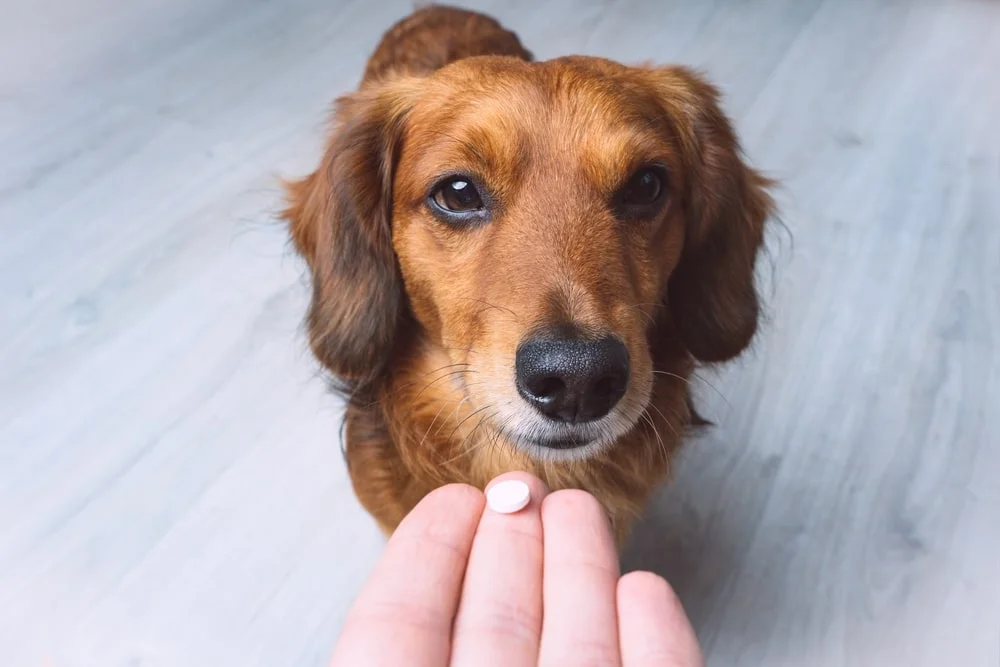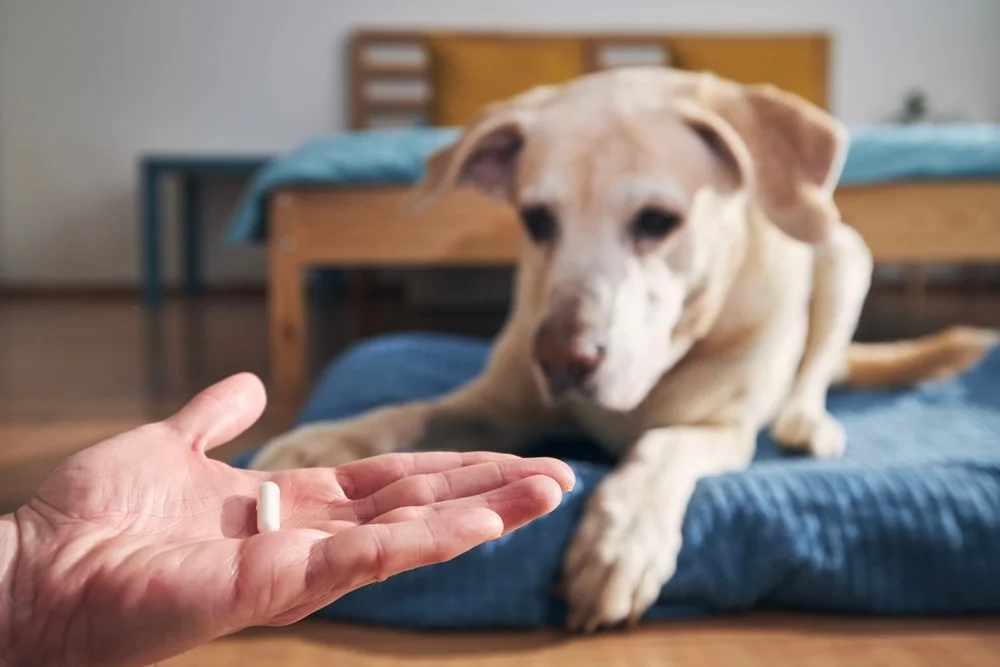PET HEALTH
How To Give Your Pet Medication
If you have cats or dogs, it’s almost guaranteed that you’ll have to give your pet medication at some point during their lifetime. Depending on the medication, this can be tricky — particularly with cats. We’re here to help get your pets the medication they need with minimal stress or damage.
Dogs tend to be food-motivated, so usually offering human food or treats with medicine can help. Meanwhile, cats can be a little more difficult, and you’ll want to protect yourself from their sharp claws. The best way to do this is to wrap them in a blanket or towel like a burrito. You can also use this method for smaller dogs. Be sure to do the following:
- Ensure your arms, legs, and face are essentially covered with long sleeves, jeans, etc.
- Find a towel or blanket.
- Approach your pet calmly with a blanket or towel.
- Pick up your cat or dog, and hold their paws close to their body.
- As gently but quickly as possible, wrap your pet in the towel or blanket.
- Keep wrapping. Only your pet’s head should protrude from the bundle, like a cat or dog burrito. Wrap your pet securely, but not so tightly that they’re uncomfortable. The goal is to immobilize the paws — and if you have a cat, keep their razor-sharp talons from your (protected but still vulnerable) skin.
Now that you’ve got the burrito method down, let’s explore how to administer different types of pet medication. Here are some tips for administering pet medication based on each type.
Liquid Medicine
When giving your dog or cat liquid medication, you’ll want to make sure you get it down the back of their throat and that they’ve actually swallowed it. Here's a breakdown of how to give your pet liquid medicine:1
- Begin by filling a syringe with the medication where your pet can’t see you.
- Hold your pet firmly or burrito-wrap them.
- Put one hand over your pet’s muzzle, with your thumb on one side and your fingers on the other. Your free hand should hold the syringe.
- Place the dispenser or syringe at the corner of their mouth.
- Apply firm pressure to the corner of your pet’s mouth to open it, and insert the syringe or dropper between one of their canine teeth and their back molars.
- Angle the syringe toward the back of the mouth and push or squeeze to dispense the medication onto their tongue.
- Lightly stroke their throat to help them swallow.
- Watch for them to lick their lips to be sure the medication has gone down the hatch. If they didn’t swallow all of it, don’t give them more medication to make up for it.
How to give a cat liquid medicine
If your cat is giving you a hard time, there’s an alternative method you could try. Squirt the medication onto their foreleg. Cats don’t like to be messy and will often lick the medication off of their leg.
Don’t try this method with dogs, as some dogs don't mind being messy.
How to give a dog liquid medicine
If your dog won’t take a syringe, you can try to mix the medication into a small amount of canned dog food and water. Make the dog food gravy-like with water prior to squirting in the oral medication.
Pain Relief Doesn’t Have To Cost a Lot
Pills
There are typically two ways to give pets pills — either wrapped in food or placed directly into the back of their mouth. If you need to know how to give your dog or cat pills without food, you can use your fingers or a pill-dispensing syringe to stick the pill in the back of their throat.2 Here’s how you can do it:2
- Hold or burrito-wrap your pet in place.
- Tilt their head up until their jaw opens. Press down on their lower lip and front teeth to open the jaw wider if need be.
- Using your fingers or a pill dispenser, quickly and gently put the pill as far back in their mouth as you can, ideally past the back of their tongue.
- Close their mouth and massage their throat to help them swallow.
The best way to give your dog or cat a pill is through their favorite food or snack. Hide pills inside a piece of canned food, peanut butter, cheese, or other treats. A great way to disguise pills is through pill pockets, which your pet may mistake as a tasty treat instead of medication.
Before you wrap that pill in something yummy, it’s essential that you ask your veterinarian if you can give your pet’s medication with food.
How to give a cat a pill with food
Cats love their treats. Try wrapping or hiding cat pills in one of these ingredients:3
- Tuna
- Wet cat food
- A soft treat
How to give a dog a pill with food
Since dogs are usually food-motivated, hiding the pill in their favorite treat can work wonders. Here are some of the best foods to hide dog pills in:4
- Cooked chicken
- Peanut butter
- Certain soft cheeses
Topical Medications
You can apply topical medications, or transdermal medications, right onto your pet’s skin. They come in antibiotic creams, ointments, gels, and patches with the medication suspended in them. For example, you may be familiar with heartworm, flea, and tick preventatives that you periodically apply right to your pet’s skin.
There’s no significant difference between applying topical medicine to a cat or a dog. Here’s how to go about it:5,6
- Hold your pet still. If your pet won’t stay still, a second person can help you. With cats and small dogs, you can always wrap them in a towel or blanket to help restrain them.
- Follow the application instructions from the box or your veterinarian, and apply the topical medication.
- Apply the medicine somewhere your pet won’t lick or paw at. If it’s a medication that doesn’t need to be applied in a specific area, the best option for this is typically in between their shoulder blades. If that’s not an option, they may need to wear an Elizabethan collar (cone) until the treatment has been absorbed.
Injections
While liquids, pills, and topical medicines are more common, some health conditions do need regular injections. For example, cats or dogs with diabetes may need insulin shots, or pets with allergies may need allergy shots. If your vet recommends it, and you’re comfortable giving your cat or dog shots at home, pet injections may become a part of your daily routine. Giving your pet a shot may be intimidating, but both you and your pet will get used to it.7
You’ll give your dog or cat an injection in their subcutaneous tissue (under the skin).8 Here are the steps to giving your pet a shot:6
- Fill the syringe.
- Hold or wrap your pet to keep them still.
- Pinch their skin between their shoulder blades or along their back.
- Hold the syringe with your dominant hand and slide it into your pet’s skin at a 45-degree angle.
- Push the syringe to dispense the medication quickly, then remove it.
- Massage your pet over the site of the injection.
Eye drops
Giving your dog or cat eye drops is crucial to helping them recover from an eye infection or eye surgery.9 However, holding your pet’s eye open enough to administer drops can be a challenge. As always, do whatever you can to make it a positive experience, whether that means petting them, giving them treats, or playing with them. Here’s how to give your cat or dog eye drops:10
- Wash your hands to protect your pet’s eyes from infection.
- Wipe their face and around their eyes with a warm washcloth.
- Wrap your pet in a towel or otherwise hold them still.
- Hold the bottle with your dominant hand resting on your pet’s head.
- Gently pull the upper eyelid back with two fingers.
- Hover the bottle directly over your pet’s eye without touching it, and squeeze out the prescribed number of drops.
- Let your pet blink to distribute the eye drops.
Inhalers
Metered dose inhalers (MDIs) may be used to treat asthma, bronchitis, or other respiratory illnesses in pets. The process is the same for cats and dogs. Essentially, the inhaler should come with a chamber and fitted mask. You’ll connect them and apply the mask to your pet’s face to help them inhale the medicine. Here’s a breakdown of the process:11
- Follow the instructions on the inhaler to prepare it and connect the mask.
- Wrap your pet or otherwise hold them still.
- Put the mask over their mouth and nose, and hold it securely.
- Dispense the inhaler.
- Watch your pet take at least 10 breaths before you remove the mask.
- Clean their face.
Give Your Pet Medicine With Confidence
Whether you’re giving your dog medicine for an upset stomach or your cat pain medications, administering your pet’s medication can be quite difficult. No matter what kind of medicine you’re giving your pet, be sure to offer positive reinforcement in the form of treats, pets, or play. This way, they have something good to attach to the experience. Remember, some dogs and cats respond well to taking their medication, whereas others may give you a difficult time with every dose!
Experiment and find what works for you and your pet. As always, check with your vet before administering any medications, and ask your pet insurance carrier if they’ll cover any prescriptions. MetLife Pet may cover veterinary prescriptions depending on the policy and coverage. Get started with a free quote today!
Help Keep Your Pet Healthy and Happy



